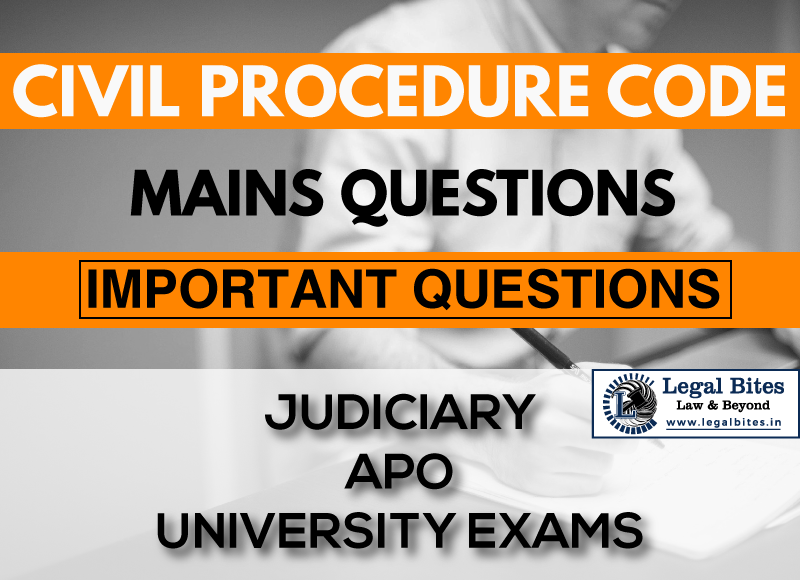History of the Code of Civil Procedure
Explore the 'History of the Code of Civil Procedure' in our informative article on Legal Bites.;

History of the Code of Civil Procedure | Overview Introduction Highlights of Amendment Act, 1976 Amendment Act of 1999 and 2002 Codification of CPC Object Retrospective Operation Introduction The Uniform Code of Civil Procedure in the Republic of India first came into effect in 1859. Before that, there were numerous kinds of civil law procedures followed in different areas of the nation. The Code of 1859 could not extend its applicability to the Supreme Courts under the...
History of the Code of Civil Procedure | Overview
- Introduction
- Highlights of Amendment Act, 1976
- Amendment Act of 1999 and 2002
- Codification of CPC
- Object
- Retrospective Operation
Introduction
The Uniform Code of Civil Procedure in the Republic of India first came into effect in 1859. Before that, there were numerous kinds of civil law procedures followed in different areas of the nation. The Code of 1859 could not extend its applicability to the Supreme Courts under the Presidency towns and to the Presidency Small Cause Courts.
After that, a few amendments were made to this and subsequently, the code was applied to the whole of the British Republic of India, whereas there have been a few deformities in it, thus, another code was enacted in 1877. Later, another code was enacted in 1882, that was conjointly changed every now and then.
In 1908, this Code of Civil Procedure was ratified. Which was again amended twice through Amendments Acts of 1951 and 1956. On the whole, this code worked agreeably, despite the fact that there have been a few imperfections in it.
The Law Commission in its various reports made a few suggestions, and once thoroughly thinking about them, the govt. set to table the Bill for the amendment in the Code of Civil Procedure, 1908, keeping in sight, the consequent concerns.[1]
- A party ought to get a fair trial in accordance with the accepted principles of natural justice;
- Every effort ought to be created to expedite the disposal of civil suits and proceedings, in order that justice might not be delayed
The procedure shall not be troublesome, and should, to the most extreme degree conceivable, guarantee a decent arrangement to the less fortunate segments of the network who don’t have a way to connect with a legal advisor to defend their cases.
Highlights of Amendment Act, 1976
Some of the vital changes made by the Amendments Act, of 1976 are as follows:
- The doctrine of res judicata is being made more practical.
- Power to transfer proceedings from one high court to a different is conferred upon Supreme Court.
- Freedom from the attachment of a portion of regular payment to any or all salaried employees was granted.
- Provision of giving notice under Section 80 before the institution of a suit against the govt. or a public officer is made less rigorous.
- Restrictions are obligatory on the right of appeal and revision.
- Provisions were created to make sure that written statements and documents were filed without delay.
- New order 32-A has been inserted to provide a special procedure in a judicial proceeding regarding the affairs of a family.
- The practice of passing a preliminary and final decree in certain suits is abolished.
- Scope of summary Trials is considerably widened.
- Important changes have been created to provide relief to poorer sections of the community.”
So as to dispose of cases efficiently the amendments of 1976 weren’t found adequate. For which, Justice Malimath Committee was appointed by the govt. With the recommendations of the Committee, the Code of Civil Procedure was amended by the Amendment Acts of 1999[2] and 2002[3].
Amendment Act of 1999 and 2002
Significant revisions made by the Acts of 1999 and 2002 are abridged along these lines:
- In many matters, like the provision of issuing summons, filing of a written statement, amendment of pleadings, production of documents, the examination of witnesses, the pronouncement of judgments, preparation of decree, etc., a time limit is prescribed;
- Number of adjournments are “restricted;
- A provision for the recording of evidence by the Court Commissioner has been made;
- Endless arguments are sought after to be shortened by (a) empowering the court to repair a time limit for oral arguments, and (b) by permitting written arguments to be placed on record by the parties;
- A provision is created for filing of an appeal within the court which passed the decree;
- Instituting of appeal against the judgement is allowed wherever the decree isn’t drawn up;
- A new provision for settlement of disputes outside the court has been introduced;
- Scope of First Appeal, Second Appeal, Letters Patent Appeal and Revision has been curtailed.”
Codification of CPC
The Preamble of the Code expresses that the object of the Code is to consolidate and amend the laws about the system of Courts of Civil Judicature. To combine implies that to assemble every one of the laws about a given subject and to bring it directly down to date all together that it should frame a valuable Code pertinent to the conditions existing at the time once the solidifying Act is sanctioned.[4]
The very object of classifying a specific part of the law is that on any point explicitly addressed, the law should from there on be seen from the language utilized in that enactment and not from the previous Act.[5]
The code of Civil procedure may be a consolidated Code of the procedure to be followed by civil courts. As determined in Prem Lala Nahata v. Chandi Prasad Sikaria[6], the code consolidates and amends the laws concerning the procedure of the courts of Civil Judicature. no doubt it additionally deals with certain substantive rights. However, its essential object is to consolidate the law about civil procedure.
Object
The Code of Civil Procedure aims to unite and alter the laws with reference to the procedure of Courts of Civil Judicature. it’s a solidified code assembling all the laws about the strategy to be adopted by civil courts. it is intended to facilitate justice and further its closures and is certainly not a penal enactment for punishments and penalties, not a thing intended to entangle people. Too specialized a development of segments that leaves no area for sensible flexibility of elucidation should, thus, be made preparations for, on condition that equity is done to both sides.[7]
The provision of the code has evolved as a matter of long years of expertise emanating out of the common law of European Country.[8]
As the Supreme Court expressed, procedural law is usually in aid of justice, not in contradiction or to defeat the terrible object that is wanted to be achieved. Procedural law is usually subservient to the substantive law. Nothing is often given by a procedural law what’s not sought to be given by substantive law and nothing will be removed by the procedural law what’s given by the substantive law.[9]
Retrospective Operation
It is a well-settled principle of interpretation of statutes that procedural laws are perpetually retrospective in operation unless there are good reasons to the contrary.[10] Their provisions can apply to proceedings already commenced at the time of their enactment. The explanation is that nobody will have an unconditional right in kinds of procedures.[11] The Code of Civil Procedure isn’t retrospective in operation.[12]
[1] Statement of Object and Reasons of Amendment Act 104 of 1976.
[2] Act 46 of 1999.
[3] Act 22 of 2002.
[4] Administrator general of Bengal v. Prem lal Mullick, ILR (1859) 22 Cal 788 (PC).
[5] Narendra Nath Sircar v. Kamalbasini Dasi, ILR (1896) 23 Cal 563 (PC).
[6] (2007) 2 SCC 551
[7] Chinnammal v. o. Arumugham, AIR 1990 SC 1828
[8] Subrata Roy Sahara v. Union of India, (2014) 8 SCC 470
[9] Saiyad Mohd. Bakar v. Abdulhabib Hasan, (1998) 4 SCC 343
[10] Nani Gopal Mitra v. State of Bihar, AIR 1970 SC 1636
[11] Anant Gopal v. State of Bombay, AIR 1958 SC 915
[12] Mohanlal Jain v. Sawai Man Singhji, AIR 1962 SC 73


